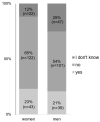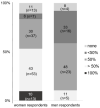'Status Quo' on Different Aspects of Gender Distribution in Rheumatology in Germany-Results from a Nationwide Online Survey among Physicians
- PMID: 37445363
- PMCID: PMC10342364
- DOI: 10.3390/jcm12134328
'Status Quo' on Different Aspects of Gender Distribution in Rheumatology in Germany-Results from a Nationwide Online Survey among Physicians
Abstract
Objectives: Despite the increasing number of female medical students and fellows in Europe, women are still under-represented in higher academic careers and positions in medicine. The aim of this survey was to assess the 'status quo' on gender distribution among rheumatologists in Germany.
Methods: A web-based anonymous survey (21 questions with multiple answers and free text) using QuestionPro® was distributed among rheumatologists in Germany via newsletters, social media and personal contact, including questions regarding hierarchical positions and work characteristics.
Results: Among the total of 170 respondents (72% women, 28% men, 1% diverse), 48% were rheumatologists in training, 35% were trained rheumatologists and 7% were heads of rheumatology departments. Regarding the gender ratio at different hierarchical levels, 74% of respondents reported more men than women in leadership positions. Part-time work was possible in the departments of 86% of respondents, with more women working part-time (56%) compared to men (29%). Most respondents stated their impression that employees working part-time did not have the same career chances as full-time workers in their departments. In total, 66% agreed that activities to improve gender equity are necessary. The highest need was seen in reconciling work and family through, e.g., part-time models, flexible childcare options at work and a higher acceptance of part-time work in leadership positions.
Conclusions: According to our results, a gender imbalance is prevalent among rheumatologists in Germany, with lower numbers of women evident at higher hierarchical levels. Traditional role assignments are still represented by a higher proportion of part-time work in women. The establishment of structural changes to achieve better gender equity is needed.
Keywords: gender distribution; gender equity; rheumatology.
Conflict of interest statement
The authors declare that they have no competing interests.
Figures




References
-
- Kuhlmann E., Ovseiko P.V., Kurmeyer C., Gutiérrez-Lobos K., Steinböck S., Von Knorring M., Buchan A.M., Brommels M. Closing the gender leadership gap: A multi-centre cross-country comparison of women in management and leadership in academic health centres in the European Union. Hum. Resour. Health. 2017;15:2. doi: 10.1186/s12960-016-0175-y. - DOI - PMC - PubMed
LinkOut - more resources
Full Text Sources

